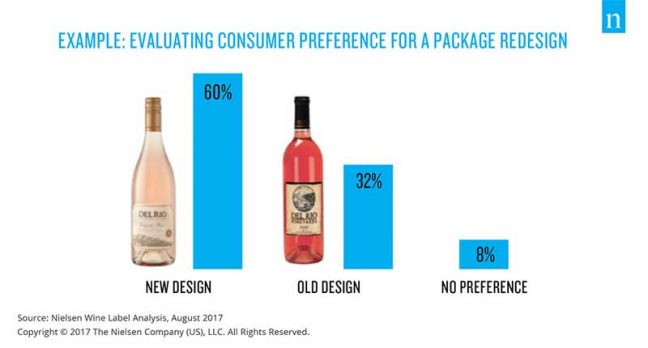As of June 2017, more than 3,500 new wine products had hit shelves in the last year, representing 14 percent of all items in the category and 4.5 percent of category sales volume. But the influx isn’t just giving consumers an array of new brands to choose from; it’s forcing retailers to make tough choices about how to use their finite shelf space.
With this many options at consumers’ fingertips, wine manufacturers and retailers need to understand the factors that influence wine purchase decisions. And in the wine category, where traditional media spending is low, the “advertising” that happens at the shelf is particularly important, making label design a key purchase driver in an increasingly crowded wine market.
According to Nielsen’s “Beverage Alcohol Category Shopping Fundamentals” study, only 29 percent of consumers know which brand they intend to buy before they enter a store. The remaining 71 percent of consumers are making their decisions as they peruse the options on the shelf. So what can wine manufacturers take to stand out and land in consumers’ baskets?
Conduct a pack health assessment
Understanding package design trends is critical, and that means assessing design performance on a variety of dimensions. First, does a design grab consumers’ attention quickly? In a recent label analysis of 20 wine brands that utilized eye-tracking technology, 57 percent more consumers saw the most visible bottle than the least-visible bottle within the first few seconds of looking. Since consumers can’t consider purchasing a wine that they don’t see or notice, strong standout is a key requirement for effective design.
Once consumers notice a bottle, the label needs to compel them to purchase it. For this reason, manufacturers should assess to what extent their designs reflect the brand’s personality and effectively convey key messages. Which elements are working well, and which aren’t?
Rely on market feedback and avoid personal bias
Trying to guess how consumers will react to packaging is a big challenge for manufacturers. In fact, more than half of fast-moving consumer goods (FMCG) professionals cite subjective decision-making within their company as a top complaint when asked about the biggest pain points in their company’s design process; 75 percent indicated that design decisions at their companies are made based on judgment or design by committee—whether it be group consensus (33 percent), qualitative focus groups (55 percent) or the infamous senior executive favorite (53 percent). The real way forward, however, as with most other aspects of new product development, is through quantitative consumer feedback. It’s the only dependable way to understand how a package design will perform in market.
Explore more design directions
In studying more than 90 client package redesign initiatives, Nielsen uncovered an interesting finding: As the number of designs evaluated increases, so too does the performance on key packaging metrics, including consumer preference and the ability to stand out. The unfortunate reality, however, is that most brands evaluate three or fewer design directions, while only 15 percent explore more than four options.
In Nielsen’s wine label analysis, the most preferred package redesign was Del Rio Vineyards rosé—with nearly twice as many consumers preferring the new design to the old one. The Del Rio team explored ten initial design directions—much more than the typical brand—then iterated further on a subset of those designs.
Dark Horse, a wine brand launched in 2015 by E. & J. Gallo Winery and a 2017 Nielsen Breakthrough Innovation Award winner, credits its package design as a key factor in driving trial and in ultimately helping the brand achieve $61 million in first-year sales—an impressive figure for a new entrant in the highly fragmented wine category, says Nielsen. The brand describes its creative exploration as “relentless.” The team considered more than 100 design directions, including a wide range of close-in and also very disruptive, far-out designs.
“It was crucial to create a package that had a memorable, impactful icon that also offered strong, premium wine cues so consumers would be surprised by the [low] cost,” said Stephanie Gallo, VP of marketing at E. & J. Gallo Winery.
Learn more about best practices for launching successful package designs and key findings from Nielsen’s recent wine label analysis.
The insights in this article were derived from:
Nielsen Retail Measurement Services, Total U.S. All Outlets Combined, 52 weeks ending June 17, 2017; new items with sales greater than $1,000 in latest two years combined and $0 sales three years prior
Nielsen Retail Measurement Services, Total U.S. Food, Total U.S. Combined Liquor Plus, 13 weeks ending July 15, 2017
Nielsen Ad Intel
Nielsen Beverage Alcohol Category Shopping Fundamentals Survey, 2016
Nielsen Wine Label Analysis, August 2017
Nielsen State of Package Design Industry Survey 2016
Nielsen, “Packaging Sells” analysis, 2016
Nielsen, U.S. Beverage Alcohol Off Premise channels; latest 52 weeks ending Feb. 27, 2016






